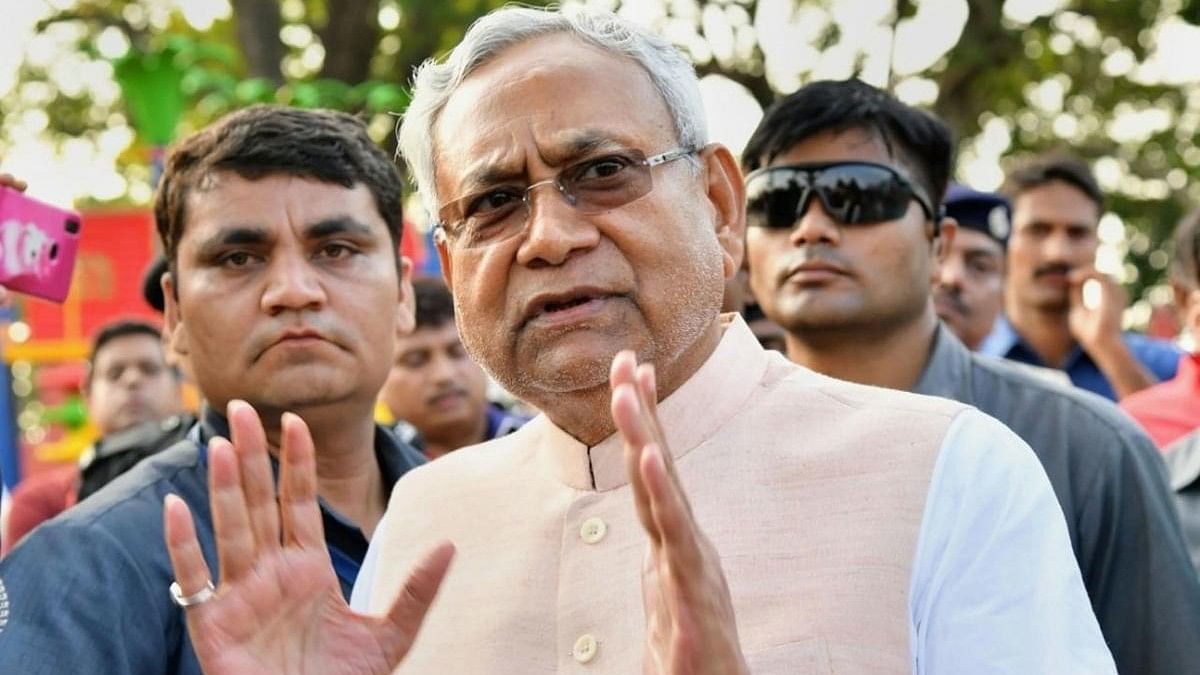
Bihar Chief Minister Nitish Kumar.
Credit: PTI Photo
Bihar is known to the outside world as a state steeped in its stories of social domination, and oppressive caste and social structures. Except for the Champaran satyagraha by Mahatma Gandhi and Rajendra Prasad in 1917, and the long social justice politics of Jagjivan Ram, Bihar always presented an imagery of a state different from the rest of India. The arrival of Lalu Prasad and Nitish Kumar into backward politics and their efforts to build an inclusive Bihar is yet to be fulfilled. More so, the carving of tribal Jharkhand in November 2000, never took away what Bihar is for India.
Lalu Prasad’s era which started in 1990 in Bihar also collided with tension and resistance of the dominant upper caste politics against the ‘mandalisation’ of politics. Into the Mandal juggernaut entered Bharatiya Janata Party (BJP) leader L K Advani’s Rath Yatra, which was famously stopped in its tracks in October 1990 by an indomitable young Lalu Prasad, who was then Chief Minister. In fact, Bihar was at the epicentre of mandal politics. Lalu Prasad’s tenure and the power struggle with Nitish Kumar within the Janata Dal paved the way for the entry of the BJP. Bihar sustained ‘mandalisation’ till the United Progressive Alliance (UPA) government floundered in 2014 and Kamandal politics took over with the dominance of the upper caste.
Nitish Kumar’s flip-flop with the BJP continued till it all boiled down to one issue — the Other Backward Class (OBC) numbers to be counted through the decennial census. The BJP-led Union government has yet to initiate the census, and has refused to enumerate the OBCs separately during the census operations. It was the demand for caste census that gave primacy and momentum to the backward politics of Bihar which would have otherwise been subsumed by the upper caste domination.
The significance of the caste survey data is two-fold. First, it grants an official status to caste numbers, mainly for OBC data which has been in the waiting since 1931. Second, it is the reaffirmation of the numbers of the politically dominant castes in Bihar. The Yadavs at 14.2 per cent are the single largest. The combined strength of 10.5 per cent upper castes includes the Brahmins (3.6 per cent), the Rajputs (3.4 per cent), the Bhumihars (2.8 per cent), and the Kayasthas (0.6 per cent). These numbers are not in sync with the actual public representation and social domination of the upper castes in Bihar.
For instance, the Bhumihar-led Ranvir Sena ravaged Dalit villages killing 21 people in Bathani Tola (1996), 61 people in Laxmanpur Bathe (1997), and 22 people in Shankar Bigha (1999); many of these killers were later acquitted. How is it possible that the Bhumihars who form about 2.8 per cent dominate the Dalits who are about 19.6 per cent of the state’s population? The answer lies in the social domination and disproportionate power the Bhumihars enjoy, which arises from the caste system. The household assets and economic data of castes will invariably show the economic domination of the upper castes sharpening this divide.
Another aspect of the caste census is the disproportionate presence of the Brahmins and the Kayasthas in the bureaucracy since such data was repeatedly sought in Parliament. Political parties are now interested in representational politics, as recently seen in Congress leader Rahul Gandhi’s statement in Parliament on the number of secretaries in the Union government from the OBC category. Now that the caste data is out, Bihar’s ‘Dravidian’ movement will emerge, just like it did in the Madras Presidency about a century ago against the disproportionate power held by Brahmins.
Bihar’s social fabric and politics, now, after the release of the caste census data, will see a recalibration of the Mandal moment, and will amplify the claim on the disproportionate presence of the upper castes in the bureaucracy and their socio-economic dominance. Bihar’s political landscape will never be the same again. The elements of Mandal politics will combine with a Dravidian ideological framework in the times to come, which could even have a national impact.
(Rehnamol Raveendran teaches political science at the University of Allahabad. Twitter: @Rehna_AntiCaste)
Disclaimer: The views expressed above are the author's own. They do not necessarily reflect the views of DH